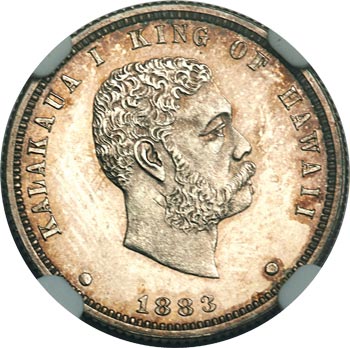Story by Peter von Buol
 Last April, two rare Hawaiian coins minted for King David Kalakaua sold at auction in a suburb of Chicago. An 1881 prototype for a Hawaiian nickel went for $25,300. An uncirculated proof of an 1883 hapawalu—one of only twenty eighth-dollar coins ever minted—sold for an astonishing $43,125.
Last April, two rare Hawaiian coins minted for King David Kalakaua sold at auction in a suburb of Chicago. An 1881 prototype for a Hawaiian nickel went for $25,300. An uncirculated proof of an 1883 hapawalu—one of only twenty eighth-dollar coins ever minted—sold for an astonishing $43,125.
The inspiration for the coins was Kalakaua’s historic 1881 trip around the world. During his travels, the king came to believe that Hawaiian coins bearing his visage and used as legal tender would project a strong fiscal image of the island kingdom to foreign nations. In Paris, Kalakaua met the owner of a New Caledonia nickel mine, who had about 200 Hawaiian nickels struck in France and shipped to Honolulu to entice the king to sign a contract. The coins never circulated—perhaps because of an embarrassing misprint in the first word of Hawai‘i’s motto.
Despite being one of four denominations authorized by the kingdom’s legislature, the hapawalu never went into circulation, either.
In 1883, one of the king’s favorite advisors, sugar baron Claus Spreckels (namesake of Maui’s north-shore Spreckelsville), financed the minting of the Islands’ official coinage at the U.S. Mint in San Francisco. Because it was cheaper to duplicate the size, shape and silver content of American coins, hapawalu were replaced, without legislative approval, by umi keneta (dimes), of which about a quarter of a million were made.
Kalkaua’s other coin issues were the hapaha (quarter-dollar), hapalua (half-dollar) and akahi dala (dollar). Sadly, most of the higher value coins were melted down soon after Hawai‘i became a U.S. territory.
Kalakaua’s coins were not the first to be minted for the Hawaiian kingdom. In 1847, King Kamehameha III issued 100,000 copper keneta, a coin resembling the American penny.





